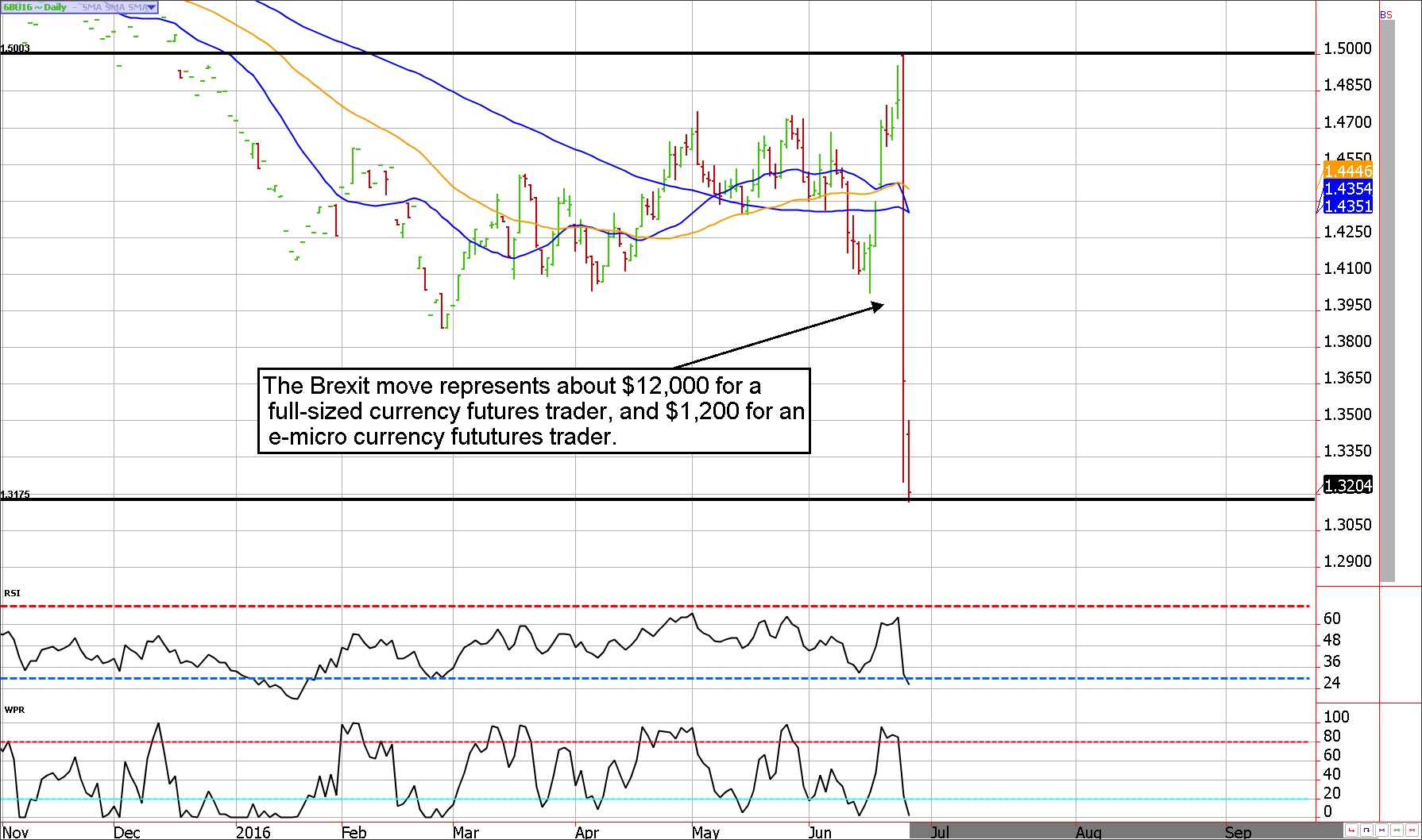It is no secret that the Brexit vote fallout has left the currency markets in turmoil. Going into the event, we were advising our brokerage clients to “lay low”. Although inexperienced traders look forward market making events with dreams of life-changing profits, I’ve been a commodity broker long enough to know that more money is lost than is made in highly volatile markets.
Even those with correct price prediction could suffer losses at the hands of a stop loss trigger, margin liquidation, or panic. Imagine being short the e-mini S&P 500 on Thursday the 23rd in anticipation of a bearish reaction to the Brexit vote with a stop loss at 2019 to protect the trade from runaway losses. After being stopped out near the high at a loss, the market dropped roughly 120 handles in favor of the hypothetical traders’ anticipated market direction. I assume there were similar occurrences across stock, Forex, and futures trading accounts around the world; particularly in the stock indices and currency markets.
For those yearning to trade the British Pound, but wishing to have reasonable risk without the stresses of being stopped out or holding an overly volatile position, there is a solution: e-micro currency futures. The e-micro British Pound futures contract is 1/10th the size of the original. For those interested in the specs, the e-micro has a contract size of 6,250 British Pounds, vs. the full-sized contract which represents 62,500 Pounds. Accordingly, the e-micro makes or loses a mere $0.625 per tick as opposed to $6.25. In a quiet market, trading the e-micro could be considered boring but in a market seeing several hundred ticks in price change per day, it suddenly becomes a relevant tool for speculators of all sizes. For example, from Friday, June 23rd to Monday the 27th the British Pound futures contract for September delivery dropped from $1.50 to about $1.31. This move represents nearly $1,200 I profit or loss for an e-micro currency futures trader. While a full-sized trader might have made or lost almost $12,000! Not surprisingly, the margin for an e-micro futures contract is a fraction of the full-sized version at $280 vs. $2,800.

In addition to the manageable contract size, a big advantage to trading the e-micro currency futures is the ability to accumulate contracts to improve the average entry price. This strategy is known loosely as scale trading and is similar to dollar-cost averaging used by equity investors. It involves the practice of buying or selling futures in increments against the current trend. For instance, a trader might look to buy an e-micro British Pound futures contract near $1.32, another at $1.31, anther at $1.30, and so on. Because traders cannot possibly expect to pick the exact high or low of a market, scaling into smaller sized futures contract will generally provide a better entry price and a higher probability of trading success. Specifically, if the goal is to be long 62,500 British Pounds one could buy a single full-sized contract paying the market price in hopes of picking the low of the move; or, he could buy a total of ten futures contracts at staggered prices. Probability suggests the average price achieved by the accumulated e-micro position will be better than the purchase price of a single full-sized contract.
Some of you might be wondering if it makes sense to look to a British Pound ETF; that is certainly a convenient way to gain exposure to the currency market but it is also a highly inefficient one. Currency ETFs are simply funds that hold and pool the underlying futures contracts, allowing investors to indirectly hold currency futures in their stock accounts. Yet, high fees, management expenses, transaction costs and other burdens strongly work against the speculation.
As we all know, markets tend to overreact to today’s news only to price in reality as time progresses. At some point, it will be time to get bullish the British Pound in hopes of the market bouncing back to some sort of equilibrium price. When that time comes, don’t forget about the e-micros!
Carley Garner is the Senior Strategist for DeCarley Trading, a division of Zaner, where she also works as a broker. She authors widely distributed e-newsletters; for your free subscription visit www.DeCarleyTrading.com. She has written four books, the latest is titled “Higher Probability Commodity Trading” (July 2016).




